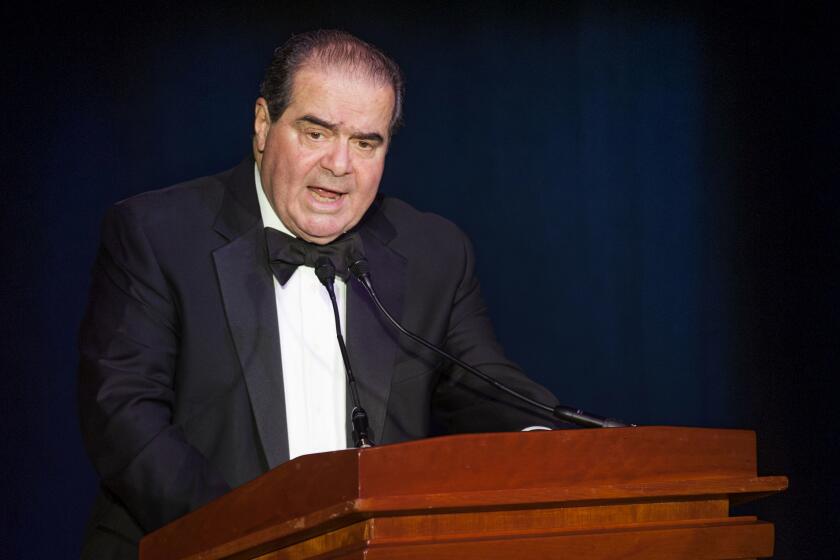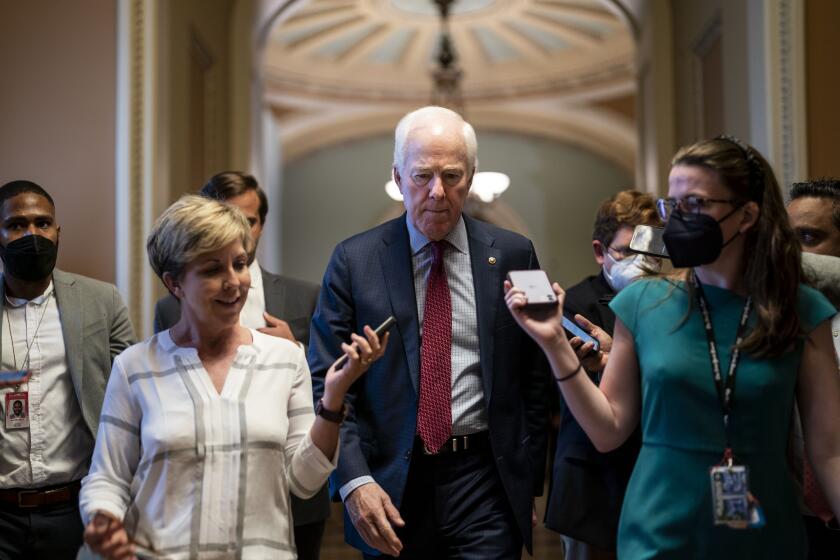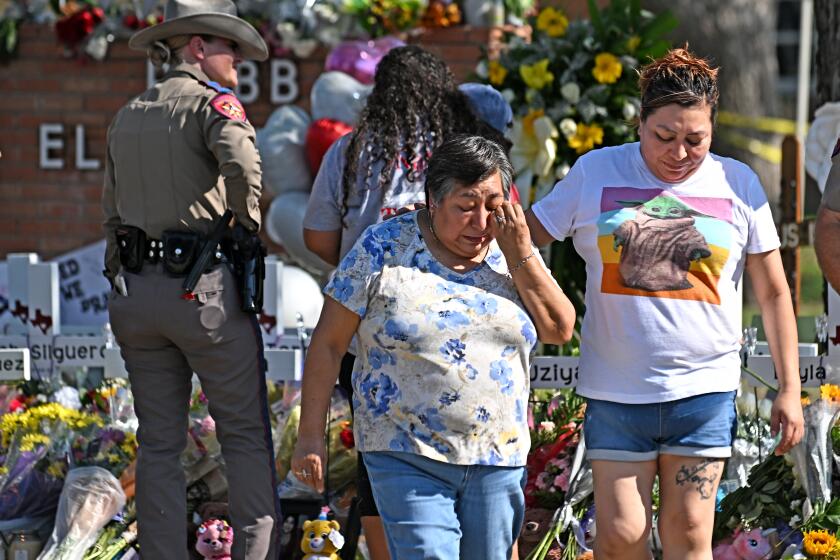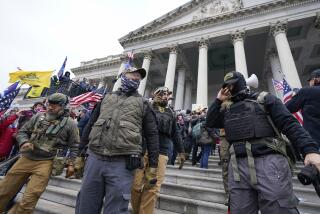Column: The Trump shooting and the glorification of guns

- Share via
Much is still not known about Saturday’s shooting at a Trump rally in Pennsylvania, but it’s clear that the incident placed the stupidity and hypocrisy of America’s gun culture in high relief.
Former President Trump was nearly assassinated while addressing the rally. One spectator seated in the bleachers near him, Corey Comperatore, 50, was killed and two spectators were critically injured and are currently hospitalized. The shooter, identified by the FBI as Thomas Crooks, 20, was killed at the scene.
That the glorification of guns erupted (again) into violence at a political gathering was always a case of not if, but when. Trump and his acolytes have infused their rhetoric with violent imagery.
They endorsed the tactics of the violent mob that stormed the Capitol on Jan. 6, 2021; Trump himself promised to pardon those who have been convicted of federal crimes in connection with the insurrection.
‘Two-thirds of our [survey] participants in 2022 and three-fourths in 2023 rejected political violence as never justified — not just in general, but for one specific objective after another.’
— Garen Wintemute, director of the California Firearm Violence Research Center
Not three weeks ago I wrote about two developments that hinted, if hazily, that the long arc of our debate over guns might be trending toward rationality.
One was an “advisory” from U.S. Surgeon General Vivek Murthy identifying firearm violence as a public health crisis. The other was a Supreme Court decision upholding a ban on gun ownership by domestic abusers.
Get the latest from Michael Hiltzik
Commentary on economics and more from a Pulitzer Prize winner.
You may occasionally receive promotional content from the Los Angeles Times.
The instant reaction by the gun rights lobby to Saturday’s shooting shows that the obstacles to that trend remain powerful indeed.
Calls to tone down the rhetoric of the presidential campaign were heard from both sides of the aisle. But not proposals to ban weapons such as those reportedly carried by the shooter, much less to tighten the laws and regulations on gun sales.
Here’s an aspect of America’s relationship with guns relevant to Saturday’s shooting: The vast majority of Americans are fearful that political violence could affect the outcome of our elections. More on that in a moment.
The weapon used by the apparent shooter Saturday was a semiautomatic AR-15, law enforcement sources say. To experts in mass shootings, this was almost predictable. The AR-15 was used in 10 of the 17 deadliest mass shootings in America since 2022, according to a roster published last year by the Washington Post.
The surgeon general calls gun violence a public health crisis, and Supreme Court conservatives get terrified by a horrific gun owner. Will that lead to more rational gun policies?
The death toll from those shootings was 207. Nevertheless, Republican members of Congress paraded around Washington last year with lapel pins bearing the weapon’s silhouette, handed out by a congressman who owned a gun shop. Among those wearing the pin was Rep. Anna Paulina Luna (R-Fla.), who was photographed with it on Feb. 1, 2023, two days after a mass shooting in her home state left 11 people wounded.
Some features of the aftermath of Saturday’s shooting are also predictable.
There will be pleas by the gun lobby not to “politicize” Saturday’s incident, as if gun control isn’t a political issue. But don’t be misled: Republicans and the right wing started politicizing the shooting within minutes.
Rep. Marjorie Taylor Greene (R-Ga.): “The Democrats and the media are to blame for every drop of blood spilled today.” Rep. Mike Collins (R-Ga.) called for Pennsylvania authorities to “immediately file charges against Joseph R. Biden for inciting an assassination.” Etc., etc. (Thanks to Kevin Drum for peering into the fever swamp and compiling the first acrid bubbles.)
As for the tone of political rhetoric, who’s responsible for its bloodthirstiness? Let’s take a look. After a violent attack at the San Francisco home of former House Speaker Nancy Pelosi seriously injured her husband, Paul, Trump lined up with a conspiracy theory that suggested that Paul Pelosi knew his attacker.
“It’s — weird things going on in that household in the last couple of weeks. ... The glass it seems was broken from the inside to the out so it wasn’t a break in, it was a break out,” he said on a right-wing radio program.
The conspiracy claims have long since been debunked. The attacker, David DePape, has been sentenced to 30 years in prison on federal charges and is awaiting sentencing on five felony convictions in state court.
Appearing at the California GOP convention last year about 11 months after the attack, Trump mocked Pelosi and her family: “How’s her husband doing, anybody know?” Trump said to a jeering crowd. “And she’s against building a wall at our border, even though she has a wall around her house — which obviously didn’t do a very good job.”
The bipartisan agreement between 20 senators demonstrates how far we are from achieving genuine gun safety legislation at the federal level.
During the 2016 campaign, Trump said that “maybe ... 2nd Amendment people” could stop his Democratic opponent, Hillary Clinton, from being able to appoint Supreme Court judges. The 2nd Amendment covers the right to bear arms.
Republican Party policy on guns is on a one-way ratchet — toward more guns and less control. After being critically wounded by a gunman and fervant opponent of Trump who took aim at a congressional outing in 2017, Rep. Steve Scalise (R-La.), a member of the House leadership, could have taken a stand in favor of better gun control. He went in exactly the opposite direction, saying that the incident reinforced his support for gun rights.
“I was a strong supporter of the 2nd Amendment before the shooting,” he said, “and frankly, as ardent as ever after the shooting in part because I was saved by people who had guns.”
“There’s no magic bill you can file to stop people from doing evil things, whether it’s with a bomb or a knife or whatever weapon they choose,” Scalise said more than a year later.
And who can forget the Christmas card mailed out by Rep. Thomas Massie (R-Ky.) in 2021, depicting himself, his wife and five children brandishing assault weapons around the Christmas tree, under the legend, “Merry Christmas! ps. Santa, please bring ammo”?
Gun rights advocates assert that they’re only reflecting the people’s will. Nothing could be further from the truth. The Gallup poll has consistently shown a majority of respondents favoring stricter laws on gun sales over the last three decades; in 2023, the figure was 56%, with only 12% favoring less strict laws and 31% accepting the laws as they are now. Since 2000, only about 34% to 42% reported “having” a gun in their home. That’s a decline since the 1960s through the mid-’90s, when the figure reached as high as 50%.
Not only our politicians and police are cowards about guns — we all are.
Those latter figures may be misleading. Researchers at Northeastern and Harvard universities found that only about 28.8% of U.S. adults personally owned firearms in 2021, with an additional 10.4% living in households with guns but not personally owning them.
Research on Americans’ concerns about political violence may be more telling. That includes data assembled by the California Firearm Violence Research Center at UC Davis.
The center reported that in its annual nationwide surveys “nearly one-third of participants (32.8%) considered violence to be usually or always justified to advance at least one political objective.
But as the center’s director, Garen Wintemute, wrote in an op-ed for the Hill, that support for this notion has been concentrated in the right wing.
Among those “much more likely than others to endorse political violence” are “Republicans and MAGA-supporting Republicans in particular; those who endorse QAnon, the white supremacy movement, Christian nationalists and other extreme right-wing organizations and movements,” he wrote.
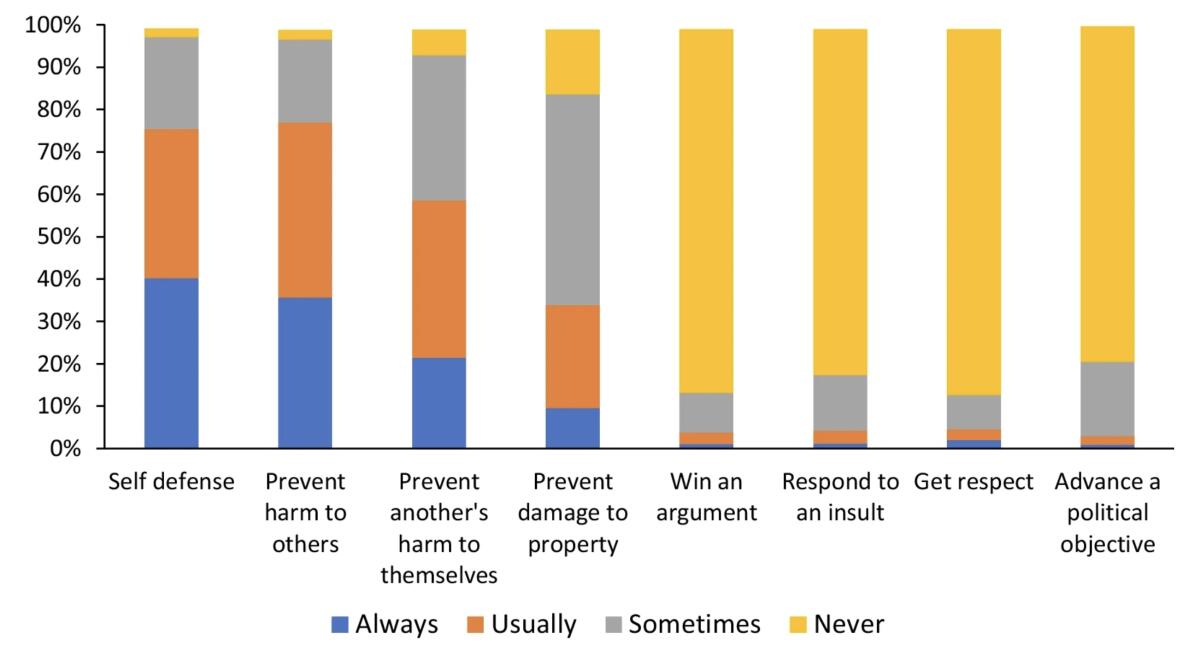
Firearm owners also supported violence for political aims, “but only by a small margin, unless they owned assault-type rifles, had bought firearms during the COVID pandemic or regularly carried loaded firearms in public.”
The center’s 2023 survey added a few specifications to this list, all drawn from the sociopathic spectrum: “Racists, sexists, xenophobes, homophobes, transphobes, Islamophobes and antisemites,” Wintemute wrote.
He added these words of optimism: “Two-thirds of our participants in 2022 and three-fourths in 2023 rejected political violence as never justified — not just in general, but for one specific objective after another. Of the participants who considered violence justified in at least one instance, the vast majority (about 70% in 2022 and 60% in 2023) were unwilling to engage in it themselves. These findings provide grounds for hope and directions for a way forward.”
As Wintemute observed, silence about the implications of these findings won’t quell the potential that a political turn could be achieved by violence.
“It’s a time to mobilize,” he wrote. “The great majority of us who reject political violence need to make our opposition known, over and over and as publicly as possible. We need to create or join movements that do the same. People pay attention to what their family, friends, co-workers, social media contacts and well-known public figures say.
“Our task is to ensure that violence doesn’t determine the outcome of this year’s elections — that 2024 isn’t the year when the term ‘battleground states’ takes on a new and bloodier meaning. It begins with each of us making and acting on this commitment: Not if I can help it.”
More to Read
Get the latest from Michael Hiltzik
Commentary on economics and more from a Pulitzer Prize winner.
You may occasionally receive promotional content from the Los Angeles Times.

